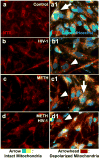Methamphetamine Augments Concurrent Astrocyte Mitochondrial Stress, Oxidative Burden, and Antioxidant Capacity: Tipping the Balance in HIV-Associated Neurodegeneration
- PMID: 28993979
- PMCID: PMC6003420
- DOI: 10.1007/s12640-017-9812-z
Methamphetamine Augments Concurrent Astrocyte Mitochondrial Stress, Oxidative Burden, and Antioxidant Capacity: Tipping the Balance in HIV-Associated Neurodegeneration
Abstract
Methamphetamine (METH) use, with and without human immunodeficiency virus (HIV)-1 comorbidity, exacerbates neurocognitive decline. Oxidative stress is a probable neurotoxic mechanism during HIV-1 central nervous system infection and METH abuse, as viral proteins, antiretroviral therapy and METH have each been shown to induce mitochondrial dysfunction. However, the mechanisms regulating mitochondrial homeostasis and overall oxidative burden in astrocytes are not well understood in the context of HIV-1 infection and METH abuse. Here, we report METH-mediated dysregulation of astrocyte mitochondrial morphology and function during prolonged exposure to low levels of METH. Mitochondria became larger and more rod shaped with METH when assessed by machine learning, segmentation analyses. These changes may be mediated by elevated mitofusin expression coupled with inhibitory phosphorylation of dynamin-related protein-1, which regulate mitochondrial fusion and fission, respectively. While METH decreased oxygen consumption and ATP levels during acute exposure, chronic treatment of 1 to 2 weeks significantly enhanced both when tested in the absence of METH. Together, these changes significantly increased not only expression of antioxidant proteins, augmenting the astrocyte's oxidative capacity, but also oxidative damage. We propose that targeting astrocytes to reduce their overall oxidative burden and expand their antioxidant capacity could ultimately tip the balance from neurotoxicity towards neuroprotection.
Keywords: Astroglia; Dynamin-related protein; Extracellular flux; Machine learning; Mitochondria; Mitofusin; Neurotoxicity; Oxidative stress.
Figures






Similar articles
-
Methamphetamine oxidative stress, neurotoxicity, and functional deficits are modulated by nuclear factor-E2-related factor 2.Free Radic Biol Med. 2015 Dec;89:358-68. doi: 10.1016/j.freeradbiomed.2015.07.157. Epub 2015 Sep 30. Free Radic Biol Med. 2015. PMID: 26427884
-
Methamphetamine causes mitrochondrial oxidative damage in human T lymphocytes leading to functional impairment.J Immunol. 2010 Sep 1;185(5):2867-76. doi: 10.4049/jimmunol.0903691. Epub 2010 Jul 28. J Immunol. 2010. PMID: 20668216 Free PMC article.
-
Enhanced oxidative stress and aberrant mitochondrial biogenesis in human neuroblastoma SH-SY5Y cells during methamphetamine induced apoptosis.Toxicol Appl Pharmacol. 2007 May 1;220(3):243-51. doi: 10.1016/j.taap.2007.01.011. Epub 2007 Feb 7. Toxicol Appl Pharmacol. 2007. PMID: 17350664
-
Methamphetamine Neurotoxicity: Neurotoxic Effects, Mechanism of Toxicity, Molecular Mechanisms and Treatment Strategies.Pak J Biol Sci. 2024 Nov;27(12):613-625. doi: 10.3923/pjbs.2024.613.625. Pak J Biol Sci. 2024. PMID: 39731431 Review.
-
The Role of α-Synuclein in Methamphetamine-Induced Neurotoxicity.Neurotox Res. 2021 Jun;39(3):1007-1021. doi: 10.1007/s12640-021-00332-2. Epub 2021 Feb 8. Neurotox Res. 2021. PMID: 33555547 Review.
Cited by
-
Important role of microglia in HIV-1 associated neurocognitive disorders and the molecular pathways implicated in its pathogenesis.Ann Med. 2021 Dec;53(1):43-69. doi: 10.1080/07853890.2020.1814962. Epub 2020 Sep 17. Ann Med. 2021. PMID: 32841065 Free PMC article. Review.
-
Glutathione in HIV-Associated Neurocognitive Disorders.Curr Issues Mol Biol. 2024 May 31;46(6):5530-5549. doi: 10.3390/cimb46060330. Curr Issues Mol Biol. 2024. PMID: 38921002 Free PMC article. Review.
-
Tryptophan depletion predicts lower positive affect in sexual minority men living with HIV who use methamphetamine.J Neurovirol. 2021 Feb;27(1):178-182. doi: 10.1007/s13365-020-00937-x. Epub 2021 Jan 18. J Neurovirol. 2021. PMID: 33460015 Free PMC article.
-
Cleaving PINK1 or PGAM5? Involvement of PARL in Methamphetamine-Induced Excessive Mitophagy and Neuronal Necroptosis.CNS Neurosci Ther. 2025 Feb;31(2):e70293. doi: 10.1111/cns.70293. CNS Neurosci Ther. 2025. PMID: 40013375 Free PMC article.
-
The impact of substance abuse on HIV-mediated neuropathogenesis in the current ART era.Brain Res. 2019 Dec 1;1724:146426. doi: 10.1016/j.brainres.2019.146426. Epub 2019 Aug 29. Brain Res. 2019. PMID: 31473221 Free PMC article. Review.
References
Publication types
MeSH terms
Substances
Grants and funding
LinkOut - more resources
Full Text Sources
Other Literature Sources
Medical
Research Materials

